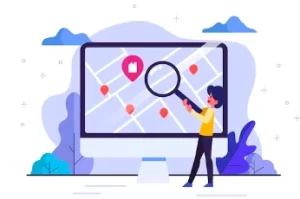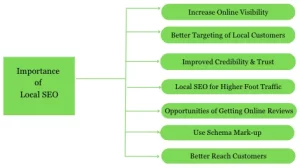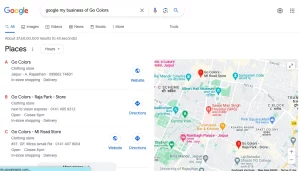Local SEO for Beginners- The Only Guide You Need
Local SEO is a big game from last more than a decade. It can be said that if you do not know SEO, you are not even a part of the game!
But don’t lose your heart to that! Here is a blog on local SEO that is important for beginners.
What is SEO?
SEO full form is search engine optimization.

It refers to improving a website’s visibility and ranking in search engine results pages (SERPs). SEO involves optimising various aspects of a website, including its content, structure, and design, to make it more appealing to search engines and users.
The main objective of SEO is to increase organic (non-paid) traffic to a website by positioning it higher in search engine rankings. When a website ranks well for relevant search queries, it has a better chance of being discovered by users actively searching for information, products, or services related to its content.
SEO involves a combination of on-page and off-page optimisation techniques.
On-page optimisation:
It focuses on optimising individual web pages by incorporating relevant keywords, creating high-quality content, optimising meta tags and headings, improving website speed and user experience, and ensuring mobile-friendliness.
Off-page optimisation:
This involves building backlinks from other reputable websites, promoting social media, and engaging in online communities to increase the website’s authority and credibility in the eyes of search engines.
Search engines, such as Google, use complex algorithms to determine the relevance and quality of websites when generating search results. SEO aims to align a website with these algorithms and best practices, making it more likely to rank higher in search results and attract targeted organic traffic.
By implementing effective SEO strategies, businesses and website owners can improve their online visibility, attract more visitors, and achieve their marketing and business goals.
Read: SEO Guidebook.
Understand local SEO
Local SEO refers to optimising a website and online presence to attract customers and improve visibility in local search results. It focuses on targeting geographically specific searches, such as “restaurants near me” or “plumbers in [city].”

Local SEO is particularly crucial for businesses with physical locations or serving specific geographic areas. It helps these businesses connect with potential customers in their vicinity and drive foot traffic to their stores or offices.
Importance of Local SEO for businesses
These are the reasons why local SEO for businesses is important:
- Application of SEO brings increased online visibility within the local market.
- You can have better targeting of local customers who are actively searching for products or services.
- With local SEO, you get improved chances of appearing in local search results and Google Maps.

- If your website appears more in the search engine, it enhances credibility and trust among local customers.
- Local SEO can result in increased foot traffic to physical store locations.
- Local businesses get higher conversion rates as local customers are more likely to make purchases or engage with businesses in their vicinity.
- Competitive advantage over businesses that do not prioritise local SEO.
- If your presence in the local market is made evident, the opportunities for building positive online reviews and managing reputation increases.
- Local SEO improves ability to reach customers at the right time and place, especially on mobile devices with location-based searches.
Key Difference between Local SEO and Traditional SEO
Local SEO is like a neighbourhood bakery focusing on delighting its nearby customers with fresh pastries and personalised service. It prioritises creating a warm and inviting atmosphere for the local community, utilising word-of-mouth recommendations, and showcasing its delectable treats in the local area.
Traditional SEO, on the other hand, is akin to a bustling city café that caters to a diverse range of customers from all over. It aims to draw attention from a broader audience by offering various menu options, implementing marketing strategies to reach customers far and wide, and establishing its brand presence in the larger marketplace.
These are the differences between the local SEO and traditional SEO tabulated to make your SEO learning easy.
| Particulars | Local SEO | Traditional SEO |
| Target Audience | Focus on local customers within a specific area | Targets a broader audience without geographic limits |
| Focus Keywords | Emphasises location specific keywords | Targets general keywords related to the industry |
| Google My Business | Utilises and optimises Google My Business Profile | Not as focused on Google My Business Optimisation |
| Local Citation | Utilises local citations and online directories | Less emphasis on local citations and online directories |
| Map Listings | Focus on appearing in local map listings | Less focus on map listings and local pack results |
| Local Reviews | Encourages and manages online reviews from local customers | Reviews are important but not specifically localised |
| Geo-Targeting | Use geo-targeting strategies for local SEO | Less emphasis on geo-targeting tactics |
| Location-specific Content | Creates content relevant to the local areas | Content may have a broader focus and not location specific |
| Physical Store Focus | It attracts traffic to physical store | Less focus on physical store visit |
| NAP Consistency | Ensures consistent Name, Address, and Phone Information across online platforms | Not as crucial to maintain NAP consistency |
| Local Link Building | Build local backlinks from relevant websites | Focuses on acquiring backlinks from various sources |
Key Components of local SEO and how to optimise them?
These are the critical components of local SEO include the following:
Google My Business (GMB):
Setting up and optimising a GMB profile is crucial. It includes providing accurate business information, such as address, phone number, and hours of operation, and managing customer reviews.

- Claim and verify your Google My Business (GMB) profile to gain control and access to manage your business information.
- Provide accurate and up-to-date business information, including name, address, phone number (NAP), website, and business category.
- Choose the most relevant and specific business category to ensure accurate categorization on Google.
- Write a compelling business description that includes relevant keywords and highlights unique selling points.
- Upload high-quality photos of your business, products, and services to showcase visually appealing content.
- Keep your business hours updated to reflect operating hours, holidays, or special events changes.
- Encourage customers to leave reviews on your GMB profile and respond to reviews promptly, both positive and negative.
- Use Google Posts to share updates, offers, events, or news about your business to engage with your audience.
- Utilise attributes in your GMB profile to provide additional information about your business, such as accessibility features or amenities.
- Regularly monitor and manage your GMB profile to ensure all information is accurate, respond to inquiries, and address any issues promptly.
- Use GMB Insights to gain insights into how customers find and interact with your business and make data-driven improvements.
- Leverage additional GMB features like Q&A, messaging, and appointment booking if relevant to your business.
Local Citations and Online Directories:
Another thing included in SEO techniques is to list your business on relevant online directories and ensuring consistent information (Name, Address, Phone – NAP) across different platforms helps search engines validate your business’s legitimacy and improves local search visibility.
- Identify relevant online directories and citation sources specific to your industry and location.
- Ensure consistency in your business Name, Address, and Phone (NAP) information across all directories.
- Claim and verify your listings on major directories like Yelp, Yellow Pages, and industry-specific directories.
- Provide accurate and complete information, including business name, address, phone number, website, and business description.
- Include relevant keywords and location-specific information in your business descriptions and titles.
- Optimize your listings with high-quality images, videos, and additional details such as business hours, payment methods, and services.
- Monitor and update your listings regularly to reflect any changes in business information, such as address or phone number updates.
- Encourage satisfied customers to leave reviews on these directories to enhance your online reputation and attract more customers.
- Respond to customer reviews, both positive and negative, to show engagement and address any concerns.
- Seek out industry-specific and local directories to expand your citation profile and improve local search visibility.
- Consider using citation management tools or services to streamline managing and updating your citations across multiple directories.
On-Page Optimization for Local SEO:
Optimising website content with location-specific keywords, including the city or region in title tags, meta descriptions, and headings, and creating location-specific landing pages.
- Conduct keyword research to identify location-specific keywords relevant to your business and target audience.
- Incorporate location-specific keywords naturally into your website’s meta tags, including title tags, meta descriptions, and header tags.
- Optimise your website’s content by including location-specific information throughout your pages and blog posts.
- Ensure your business’s Name, Address, and Phone (NAP) information is consistent and prominently displayed on your website.
- Create location-specific landing pages that provide detailed information about the areas you serve or target. For example:
- www.simpleapparells.com/suburb-1/
- www.simpleapprarells.com/suburb-2/
- www.simpleapprarells.com/suburb-3/
- Add your business address and contact information on every website, typically in the footer or header.
- Schema-markup provides structured data that helps search engines understand your business’s location and other relevant details.
- Optimise your website’s URL structure by including location-specific keywords when applicable.
- Improve website loading speed to enhance user experience, as faster-loading sites rank higher in search results.
- Make your website mobile-friendly, as most local searches are performed on mobile devices.
- Implement internal linking strategies to connect relevant location-specific pages on your website.
- Use a responsive design that adjusts the layout and appearance of your website based on the user’s device, ensuring a consistent experience across different screens.
Online Reviews and Reputation Management:
Encouraging customers to leave reviews on platforms like Google, Yelp, and industry-specific sites. Managing and responding to positive and negative reviews helps build trust and credibility with potential customers.
These are the ways in which you can work to improve your online reviews and hence make your reputation better:
- Encourage satisfied customers to leave reviews on relevant platforms like Google My Business, Yelp, or industry-specific review sites.
- Respond promptly and professionally to positive and negative reviews to show engagement and address concerns.
- Monitor online review platforms regularly to stay aware of new reviews and respond promptly.
- Encourage customers to mention specific location details and services in their reviews to enhance local relevance.
- Showcase positive reviews on your website or social media platforms to highlight your business’s positive reputation.
- Implement strategies to generate more online reviews, such as sending follow-up emails or providing incentives for leaving feedback.
- Address negative reviews by offering solutions, apologising if necessary, and demonstrating a willingness to resolve issues.
- Seek customer feedback through surveys or feedback forms to understand areas for improvement and address concerns proactively.
- Engage with customers who leave reviews by thanking them for their feedback and offering assistance if needed.
- Use online reputation management tools or services to monitor and manage your online reviews across different platforms.
- Implement strategies to encourage customers to revise or update their negative reviews after resolving their concerns satisfactorily.
- Continuously work on providing excellent products or services to enhance customer satisfaction and generate positive reviews.
Link Building for Local SEO
Acquiring backlinks from locally relevant and authoritative websites can boost local search rankings. This can be achieved through partnerships, collaborations, and engagement with local influencers or organisations. Follow these steps to bring link building into action:
- Identify local organisations, businesses, and industry influencers relevant to your business and may be interested in linking to your website.
- Engage in local community events, sponsorships, or partnerships to establish relationships and opportunities for local link-building.
- Create high-quality, valuable content specific to your local area or industry, which can attract natural links from local websites.
- Guest post or contribute articles to local publications or blogs, including links to your website in the author bio or content.
- Reach out to local bloggers or website owners who may be interested in featuring your business or content on their platforms.
- Offer to provide testimonials or reviews for local businesses or services you have used, including a link back to your website.
- Participate in local business directories or listings relevant to your industry, ensuring they include a link to your website.
- Engage with local social media groups, forums, or online communities, sharing relevant content and building relationships that may lead to link opportunities.
- Leverage local media outlets or press releases to generate news coverage or mentions that include links to your website.
- Host or sponsor local events, workshops, or webinars, which can lead to local businesses or organisations linking to your event page or website.
- Monitor your competitors’ backlinks and identify local websites they have gained links from, then reach out to those websites for potential link opportunities.
Local SEO and Content Marketing
Creating content tailored to the local audience, such as blog posts or articles discussing local events, news or highlighting local expertise. Sharing this content through local channels can enhance local search visibility.
But how can you work on it? Here are some steps for you to chase your dream of higher visibility on search engines:
- Conduct research on local topics, trends, and interests relevant to your target audience. For example, ChatGPT is one of the most searched topics these days. So you can write about topics like “How ChatGPT can help small businesses grow in the local market?” This is writing on trendy topics that are relevant for the audience.
- Create content specific to your local area, such as blog posts, articles, or guides highlighting local events, attractions, or expertise. For example if you run a travel agency, you can write on “Best places to shop in Jaipur” and inform them that you can help the readers in bookings.
- Incorporate location-specific keywords naturally into your content to enhance local search visibility.
- Share local stories or success stories about your business or customers to connect with the local community.
- Utilise social media platforms to promote and share your local content with the target audience.
- Engage with local influencers or bloggers by collaborating on content or seeking their input on local topics.
- Participate in local online communities, forums, or groups, and contribute valuable insights or information.
- Use multimedia elements like images, videos, or infographics to make your local content more engaging and shareable.
- Optimise your content for mobile devices, as many local searches are performed on smartphones or tablets.
- Encourage local readers to share your content with their networks, potentially generating more visibility and engagement.
- Monitor content performance using analytics tools to identify popular topics, engagement metrics, and areas for improvement.
- Consider hosting local events or webinars related to your industry and promote them through your content to attract local attendees.
Mobile Optimization for Local SEO- Not to miss!
As mobile usage continues to rise, ensuring that your website is mobile-friendly and optimised for local searches on mobile devices is crucial.
Follow these steps to ensure that your website is optimised for mobile devices also:
- Use a responsive design for your website to ensure it adapts seamlessly to different screen sizes and devices.
- Prioritise fast loading times by optimising images, reducing server response time, and leveraging caching techniques.
- Ensure your website’s font sizes and buttons are easily readable and clickable on mobile screens.
- Implement a mobile-friendly navigation menu that is easy to use and allows users to access essential pages quickly.
- Optimise your local business’s Google My Business profile for mobile, ensuring that all information is displayed correctly on mobile devices.
- Ensure your website’s contact information, including phone number and address, is easily visible and clickable for mobile users.
- Use mobile-friendly forms that are easy to fill out on smaller screens, making it convenient for users to contact or request information.
- Optimise your website’s mobile content using shorter paragraphs, bullet points, and clear headings.
- Implement location-based optimization by incorporating location-specific keywords and content to capture local mobile searches.
- Test your website’s mobile responsiveness and performance regularly using tools like Google’s Mobile-Friendly Test and PageSpeed Insights.
- Ensure your website is compatible with different mobile browsers and operating systems, providing a consistent device experience.
- Monitor and analyse mobile traffic, user behaviour, and conversions to identify areas for improvement and optimise the mobile user experience.
Tracking and Analytics-for Local SEO
Tracking and analytics play a crucial role in local SEO as they provide valuable insights into the effectiveness of your strategies and allow you to make data-driven decisions.
By tracking key metrics such as website traffic, keyword rankings, click-through rates, and conversion rates, you better understand how your local SEO efforts are performing. Analytics help you identify which local search tactics generate the most engagement and conversions, allowing you to optimise your strategies accordingly.
Tracking and analytics enable you to monitor your online reputation, customer reviews, and social media engagement, helping you identify improvement opportunities and promptly address any issues. Ultimately, leveraging tracking and analytics for local SEO can refine your approach, enhance your online visibility in the local market, and drive more targeted traffic and conversions to your business.
Best Tools for Local SEO
Some of the tools that you can use for monitoring and analytics and for local SEO are:
- Google Analytics: A widely used web analytics tool that provides comprehensive data on website traffic, user behaviour, conversion rates, and more. It offers valuable insights into the performance of your local SEO efforts and helps you track the effectiveness of various marketing channels and campaigns.
- Google My Business: This free tool from Google is essential for local SEO. It allows you to manage your business profile, update information, monitor reviews, and gain insights into customer engagement.
- Whitespark: Whitespark provides tools for local citation building, tracking local rankings, and managing online reviews. It also offers a local citation finder to discover relevant directories for your business.
- SEMrush: While SEMrush is primarily known as an SEO tool, it offers features specifically designed for local SEO. It provides insights into local keyword rankings, competitive analysis, and local search analytics.
- Ahrefs: Ahrefs is another comprehensive SEO tool that offers features relevant to local SEO. It provides keyword research, backlink analysis, and competitor research that can be valuable for local businesses.
- Google Search Console: This tool allows you to monitor your website’s presence in Google search results. It provides keyword rankings, click-through rates, and impressions data, helping you understand how your website performs in local searches. You can also submit your sitemap and monitor crawling and indexing issues.
- Moz Local: Moz Local is a local SEO tool that helps you manage and monitor your business listings across various online directories. It ensures consistency in your NAP information and provides insights into your visibility in local search results. It also helps you identify opportunities for improving your local search rankings.
- BrightLocal: BrightLocal is a popular local SEO platform that offers a range of tools for monitoring and managing your local SEO performance. It provides local search rankings, online reviews, citations, and competitor analysis data. It also offers features for generating local SEO reports and tracking the progress of your campaigns.
- Yext: Yext is a comprehensive platform for managing your business’s online presence, including local listings, reviews, and knowledge graphs. It allows you to update and sync your business information across multiple directories and track the performance of your listings. It also provides insights into customer sentiment and reviews.
Conclusion
Local SEO is a vital strategy for businesses aiming to increase their visibility in search engine results and attract local customers. By optimising your website, Google My Business profile, citations, content, and online reviews, you can improve your chances of appearing in local search results and reaching your target audience effectively.
If you need assistance with your local SEO strategy or have questions, please contact us at hello[at]noboruworld.com. Our team of experts is here to help you achieve higher visibility and success in local SEO.
FAQ
Why is it important to have consistent NAP (Name, Address, Phone) information across online directories for local SEO?
Consistent NAP information is crucial for local SEO because search engines rely on this data to determine the legitimacy and relevance of your business. Inaccurate or inconsistent NAP details can confuse search engines and potential customers, leading to lower search rankings and missed business opportunities. Ensuring consistent NAP information improves your local search visibility and provides a seamless user experience.
How long does it take to see results from local SEO efforts?
The time it takes to see results from local SEO can vary depending on various factors, including your industry’s competitiveness, your business’s existing online presence, and the effectiveness of your optimization strategies. Generally, it may take a few weeks to several months to notice significant improvements in local search rankings and increased visibility. Therefore, consistency, patience, and continuous optimization efforts are key to achieving long-term success with local SEO.
What role do online reviews play in local SEO?
Online reviews influence local SEO, impacting your business’s reputation, credibility, and search rankings. Positive reviews can improve your local search visibility, attract more customers, and boost your online reputation. Conversely, negative reviews can have the opposite effect. It’s essential to actively manage and encourage reviews, respond promptly, and provide excellent customer service. By cultivating positive reviews and addressing negative feedback, you can enhance your local SEO efforts and build trust with potential customers.



